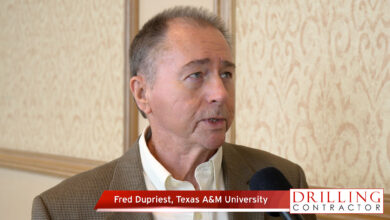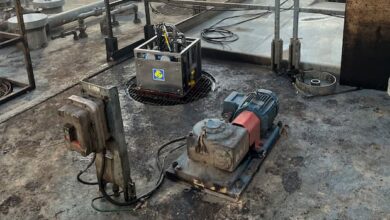Service company geomechanics group: Knowledge integration is our objective
In today’s high-cost drilling environment, the lack of integration of valuable pore pressure or other reservoir information can cost a company millions of dollars, said Colin Sayers, scientific advisor for Schlumberger’s geomechanics group. He cited an example of one oil company where the geophysics department never told the drilling department about a small fault above the reservoir, ultimately leading to a costly loss of well.
To avoid such disasters, Dr Sayers said, integration is essential. At Schlumberger, the geomechanics team is an interdisciplinary group including geophysicists, drilling engineers, petrophysicists, reservoir engineers and geologists. These experts from different disciplines typically work in close proximity to one another, often on the same floor of an office building. And because they’re all located in one department, information can flow much more smoothly, he said.
Still, it’s no small task helping operators to have the best possible knowledge about pore pressure and to make sound drilling decisions on today’s multimillion-dollar projects. Dr Sayers explained that as soon as the company gets involved in a project, it builds a mechanical earth model using every piece of information available, including geology, seismic, wireline, petrophysics and drilling information.

When a well is to be drilled, all information from that model is expressed as a DrillMap, which is a projection of a 3D Mechanical Earth Model (MEM) along a proposed well trajectory that is designed to help drillers to implement the results of the analysis.
The entire process can sometimes be complicated and time-consuming, and, despite best efforts, pre-drill predictions will contain uncertainty due, for example, to errors in the data or calibration wells being somewhat distant from the planned well.
“All models are wrong, but some are useful. Because it’s a model, we will see differences between what we observe in the well and what we predict,” Dr Sayers said. Once there is a model, the key is to continue updating it with new information obtained as drilling proceeds.
“Pore pressure models can’t stay static. A deepwater well might take $100 million to drill. You’re paying a fortune for the information you’re getting from the well – it doesn’t make sense not to update the model.”
Moreover, considering the difficulty of making measurements at 20,000-ft depth, with environment conditions of 350°F and 20,000 psi, almost any measurement that is made should be considered valuable, he pointed out.
To enable this updating process, a real-time pore pressure management engineer can play a critical role. “This engineer carefully checks for discrepencies between the prediction of the model and what is observed in the well being drilled. Once a discrepancy is observed, the engineer sends information back to the team, and they update the model. It’s crucial to feed that information back because the real time pore pressure management engineer is the eyes and ears of the geomechanics team.”
The discrepancies between prediction and observations are also great learning opportunities for improving the model. “In the past, people have drilled new wells but the information obtained while drilling has not been used to update the 3D MEM so that the best possible predrill model is available for future wells in the field. Building a Mechanical Earth Model allows the lessons learnt while drilling to be captured for use in drilling future wells.
Because this involves using geophysics, geology, petrophysics, geomechanics, etc, you need an integrated team to do this,” he said. “The concept of data integration is built into the process of the Schlumberger Data & Consulting Services (the division that houses the geomechanics group). So I would say we don’t really have a problem with knowledge integration because that’s our objective. That is the service we provide.”




